BUACC 5930: Financial Performance Analysis of Wesfarmers Retail
VerifiedAdded on 2023/06/11
|7
|1562
|297
Report
AI Summary
This report provides a detailed financial analysis of Wesfarmers Limited's key retail divisions, including Coles, Home Improvement, Department Stores, and Office Works, comparing their performance between 2016 and 2017. The analysis covers revenue, earnings before interest and tax (EBIT), segment assets, segment liabilities, and return on capital employed. The report highlights the changes in financial metrics for each division, identifying areas of growth and decline. Coles exhibits the highest revenue and EBIT, while Home Improvement demonstrates the highest return on capital employed. The report concludes with a summary of the overall financial health and performance of Wesfarmers' retail businesses, providing insights into their relative strengths and weaknesses.
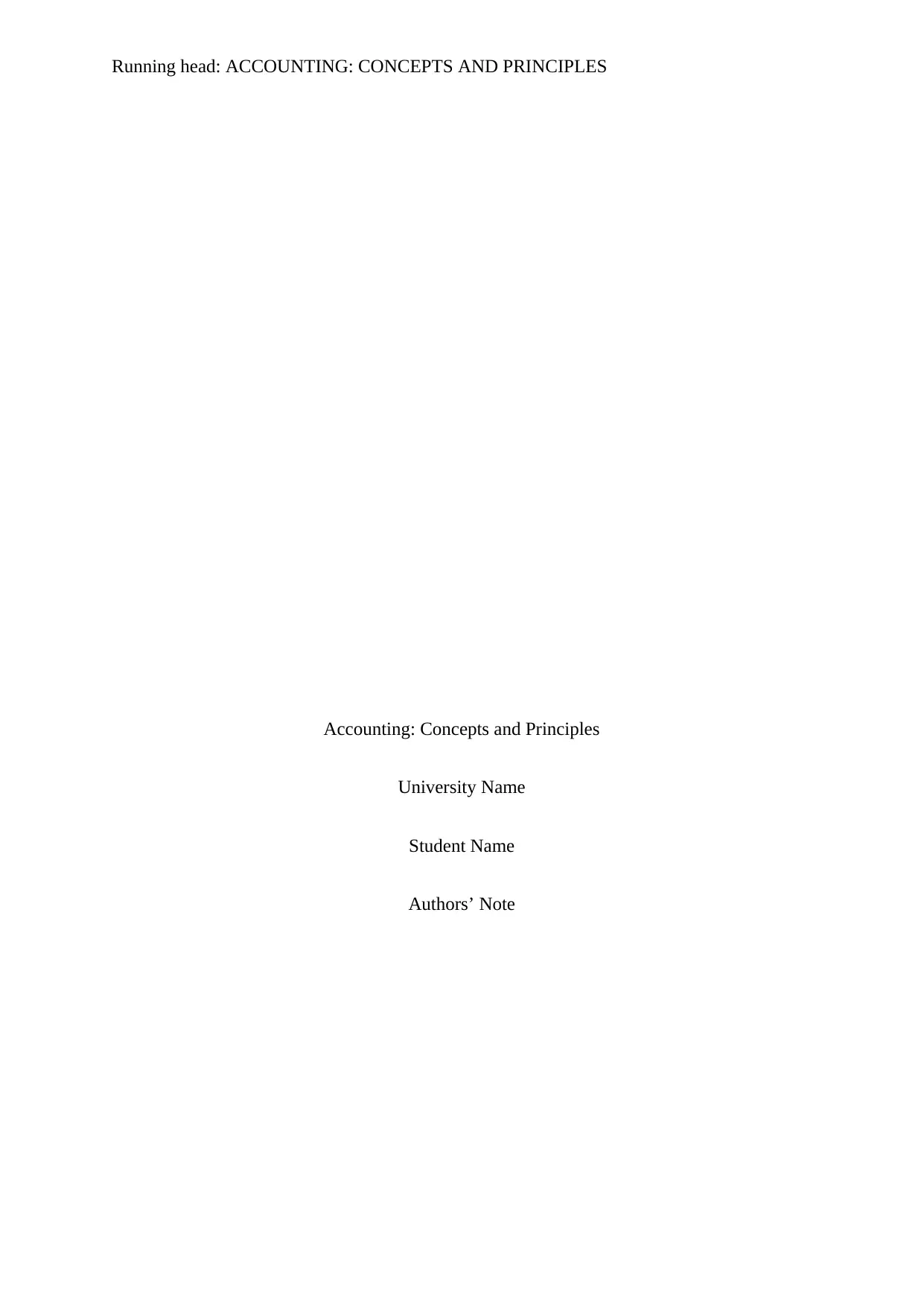
Running head: ACCOUNTING: CONCEPTS AND PRINCIPLES
Accounting: Concepts and Principles
University Name
Student Name
Authors’ Note
Accounting: Concepts and Principles
University Name
Student Name
Authors’ Note
Paraphrase This Document
Need a fresh take? Get an instant paraphrase of this document with our AI Paraphraser
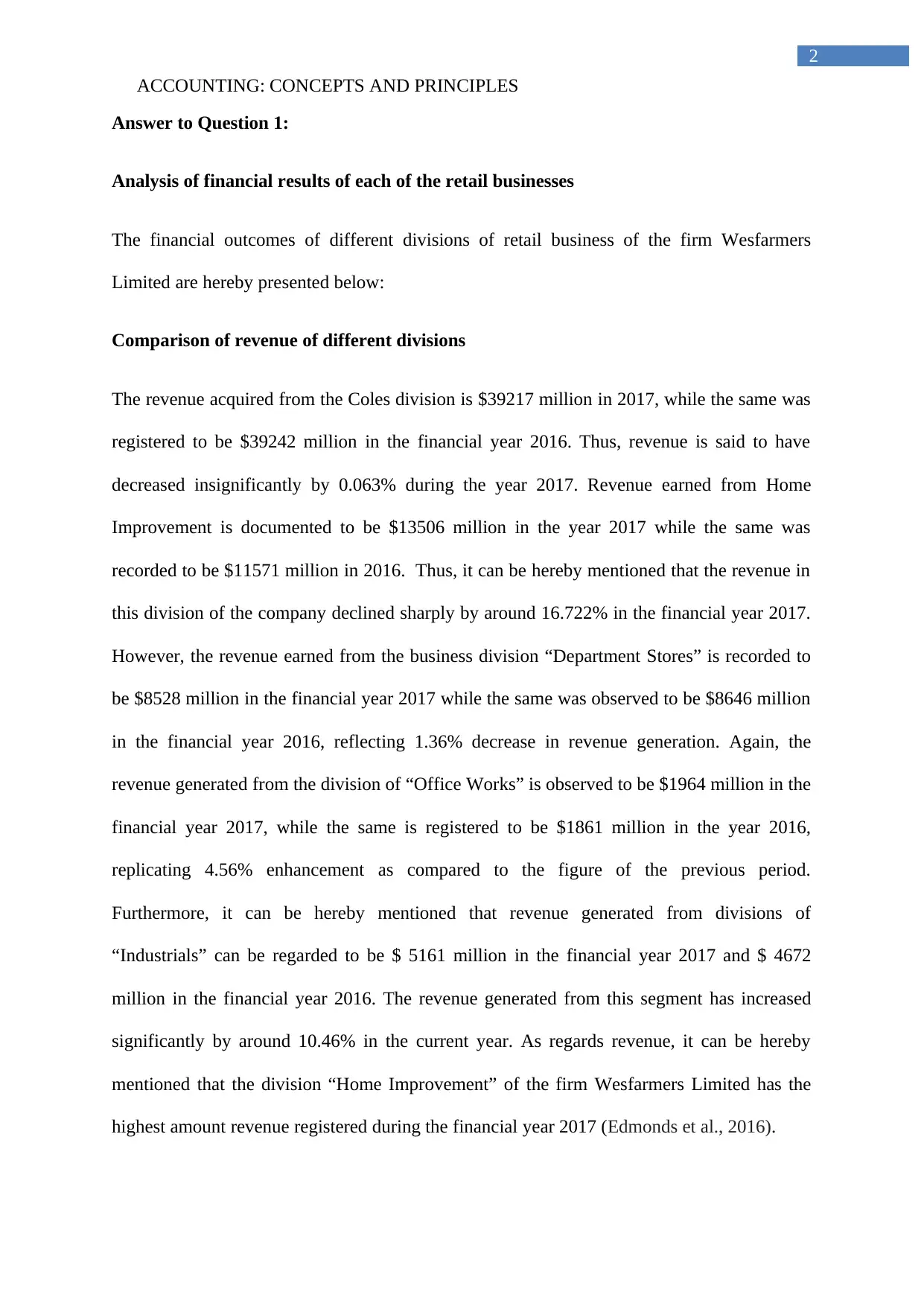
2
ACCOUNTING: CONCEPTS AND PRINCIPLES
Answer to Question 1:
Analysis of financial results of each of the retail businesses
The financial outcomes of different divisions of retail business of the firm Wesfarmers
Limited are hereby presented below:
Comparison of revenue of different divisions
The revenue acquired from the Coles division is $39217 million in 2017, while the same was
registered to be $39242 million in the financial year 2016. Thus, revenue is said to have
decreased insignificantly by 0.063% during the year 2017. Revenue earned from Home
Improvement is documented to be $13506 million in the year 2017 while the same was
recorded to be $11571 million in 2016. Thus, it can be hereby mentioned that the revenue in
this division of the company declined sharply by around 16.722% in the financial year 2017.
However, the revenue earned from the business division “Department Stores” is recorded to
be $8528 million in the financial year 2017 while the same was observed to be $8646 million
in the financial year 2016, reflecting 1.36% decrease in revenue generation. Again, the
revenue generated from the division of “Office Works” is observed to be $1964 million in the
financial year 2017, while the same is registered to be $1861 million in the year 2016,
replicating 4.56% enhancement as compared to the figure of the previous period.
Furthermore, it can be hereby mentioned that revenue generated from divisions of
“Industrials” can be regarded to be $ 5161 million in the financial year 2017 and $ 4672
million in the financial year 2016. The revenue generated from this segment has increased
significantly by around 10.46% in the current year. As regards revenue, it can be hereby
mentioned that the division “Home Improvement” of the firm Wesfarmers Limited has the
highest amount revenue registered during the financial year 2017 (Edmonds et al., 2016).
ACCOUNTING: CONCEPTS AND PRINCIPLES
Answer to Question 1:
Analysis of financial results of each of the retail businesses
The financial outcomes of different divisions of retail business of the firm Wesfarmers
Limited are hereby presented below:
Comparison of revenue of different divisions
The revenue acquired from the Coles division is $39217 million in 2017, while the same was
registered to be $39242 million in the financial year 2016. Thus, revenue is said to have
decreased insignificantly by 0.063% during the year 2017. Revenue earned from Home
Improvement is documented to be $13506 million in the year 2017 while the same was
recorded to be $11571 million in 2016. Thus, it can be hereby mentioned that the revenue in
this division of the company declined sharply by around 16.722% in the financial year 2017.
However, the revenue earned from the business division “Department Stores” is recorded to
be $8528 million in the financial year 2017 while the same was observed to be $8646 million
in the financial year 2016, reflecting 1.36% decrease in revenue generation. Again, the
revenue generated from the division of “Office Works” is observed to be $1964 million in the
financial year 2017, while the same is registered to be $1861 million in the year 2016,
replicating 4.56% enhancement as compared to the figure of the previous period.
Furthermore, it can be hereby mentioned that revenue generated from divisions of
“Industrials” can be regarded to be $ 5161 million in the financial year 2017 and $ 4672
million in the financial year 2016. The revenue generated from this segment has increased
significantly by around 10.46% in the current year. As regards revenue, it can be hereby
mentioned that the division “Home Improvement” of the firm Wesfarmers Limited has the
highest amount revenue registered during the financial year 2017 (Edmonds et al., 2016).
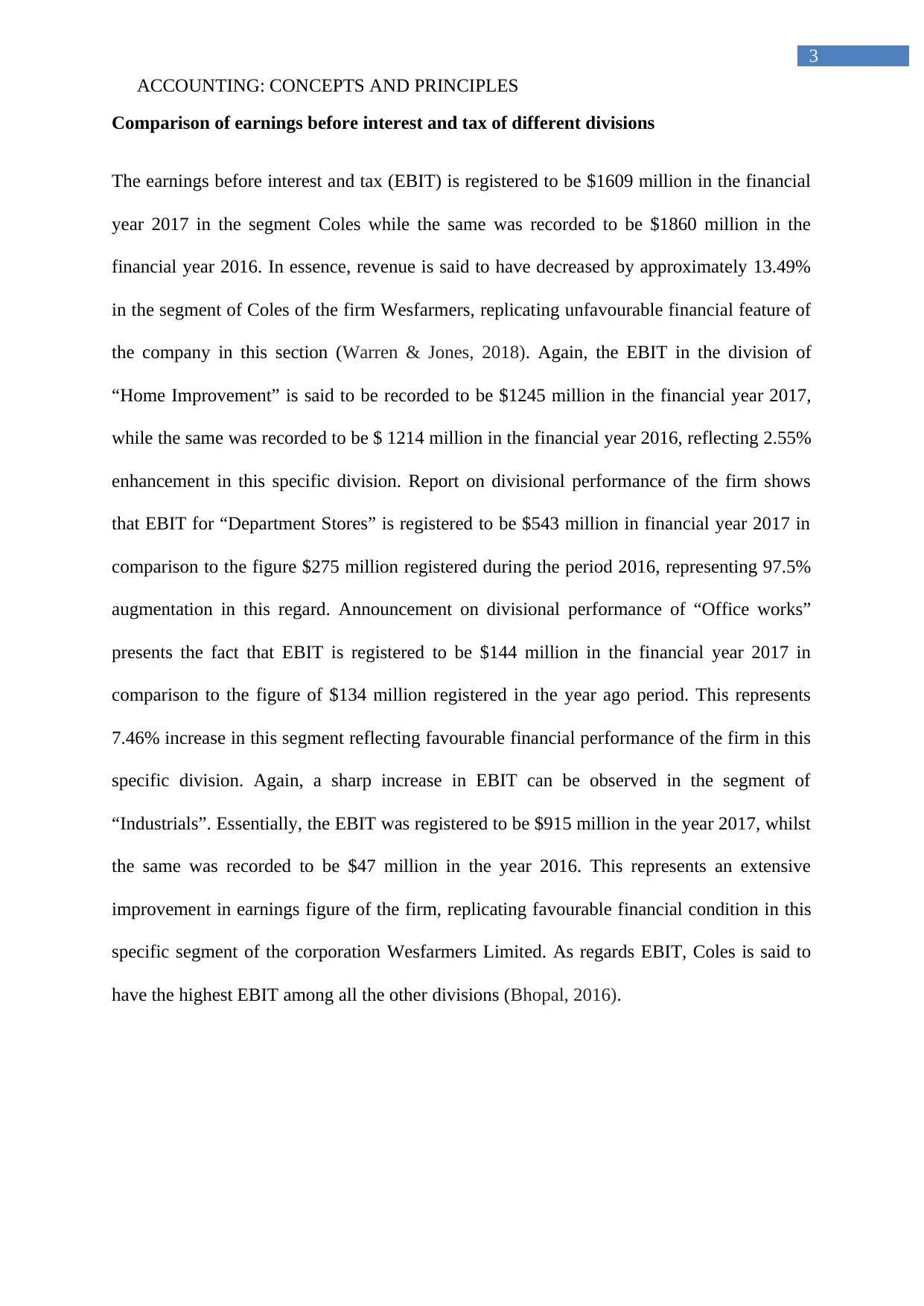
3
ACCOUNTING: CONCEPTS AND PRINCIPLES
Comparison of earnings before interest and tax of different divisions
The earnings before interest and tax (EBIT) is registered to be $1609 million in the financial
year 2017 in the segment Coles while the same was recorded to be $1860 million in the
financial year 2016. In essence, revenue is said to have decreased by approximately 13.49%
in the segment of Coles of the firm Wesfarmers, replicating unfavourable financial feature of
the company in this section (Warren & Jones, 2018). Again, the EBIT in the division of
“Home Improvement” is said to be recorded to be $1245 million in the financial year 2017,
while the same was recorded to be $ 1214 million in the financial year 2016, reflecting 2.55%
enhancement in this specific division. Report on divisional performance of the firm shows
that EBIT for “Department Stores” is registered to be $543 million in financial year 2017 in
comparison to the figure $275 million registered during the period 2016, representing 97.5%
augmentation in this regard. Announcement on divisional performance of “Office works”
presents the fact that EBIT is registered to be $144 million in the financial year 2017 in
comparison to the figure of $134 million registered in the year ago period. This represents
7.46% increase in this segment reflecting favourable financial performance of the firm in this
specific division. Again, a sharp increase in EBIT can be observed in the segment of
“Industrials”. Essentially, the EBIT was registered to be $915 million in the year 2017, whilst
the same was recorded to be $47 million in the year 2016. This represents an extensive
improvement in earnings figure of the firm, replicating favourable financial condition in this
specific segment of the corporation Wesfarmers Limited. As regards EBIT, Coles is said to
have the highest EBIT among all the other divisions (Bhopal, 2016).
ACCOUNTING: CONCEPTS AND PRINCIPLES
Comparison of earnings before interest and tax of different divisions
The earnings before interest and tax (EBIT) is registered to be $1609 million in the financial
year 2017 in the segment Coles while the same was recorded to be $1860 million in the
financial year 2016. In essence, revenue is said to have decreased by approximately 13.49%
in the segment of Coles of the firm Wesfarmers, replicating unfavourable financial feature of
the company in this section (Warren & Jones, 2018). Again, the EBIT in the division of
“Home Improvement” is said to be recorded to be $1245 million in the financial year 2017,
while the same was recorded to be $ 1214 million in the financial year 2016, reflecting 2.55%
enhancement in this specific division. Report on divisional performance of the firm shows
that EBIT for “Department Stores” is registered to be $543 million in financial year 2017 in
comparison to the figure $275 million registered during the period 2016, representing 97.5%
augmentation in this regard. Announcement on divisional performance of “Office works”
presents the fact that EBIT is registered to be $144 million in the financial year 2017 in
comparison to the figure of $134 million registered in the year ago period. This represents
7.46% increase in this segment reflecting favourable financial performance of the firm in this
specific division. Again, a sharp increase in EBIT can be observed in the segment of
“Industrials”. Essentially, the EBIT was registered to be $915 million in the year 2017, whilst
the same was recorded to be $47 million in the year 2016. This represents an extensive
improvement in earnings figure of the firm, replicating favourable financial condition in this
specific segment of the corporation Wesfarmers Limited. As regards EBIT, Coles is said to
have the highest EBIT among all the other divisions (Bhopal, 2016).
⊘ This is a preview!⊘
Do you want full access?
Subscribe today to unlock all pages.

Trusted by 1+ million students worldwide
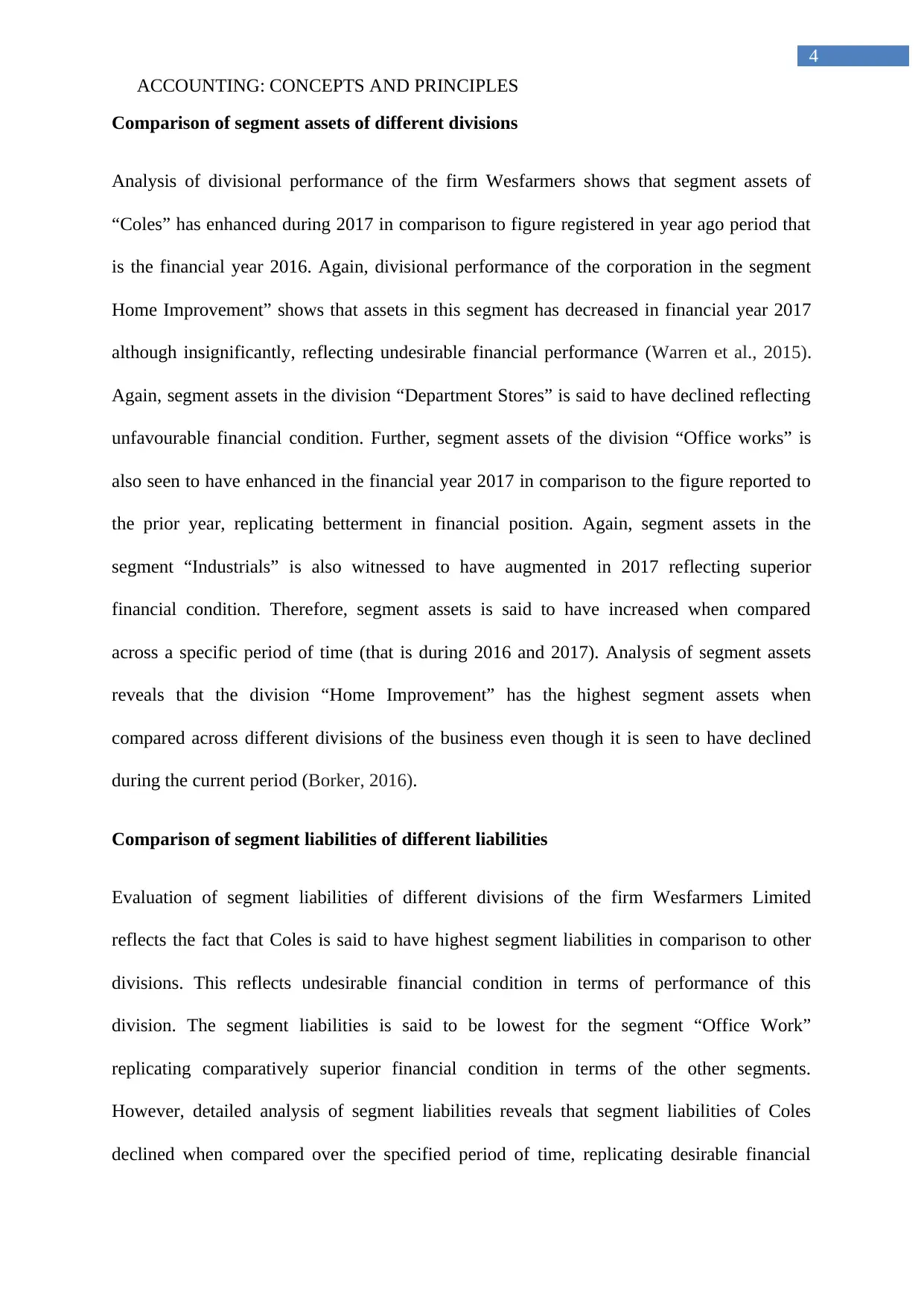
4
ACCOUNTING: CONCEPTS AND PRINCIPLES
Comparison of segment assets of different divisions
Analysis of divisional performance of the firm Wesfarmers shows that segment assets of
“Coles” has enhanced during 2017 in comparison to figure registered in year ago period that
is the financial year 2016. Again, divisional performance of the corporation in the segment
Home Improvement” shows that assets in this segment has decreased in financial year 2017
although insignificantly, reflecting undesirable financial performance (Warren et al., 2015).
Again, segment assets in the division “Department Stores” is said to have declined reflecting
unfavourable financial condition. Further, segment assets of the division “Office works” is
also seen to have enhanced in the financial year 2017 in comparison to the figure reported to
the prior year, replicating betterment in financial position. Again, segment assets in the
segment “Industrials” is also witnessed to have augmented in 2017 reflecting superior
financial condition. Therefore, segment assets is said to have increased when compared
across a specific period of time (that is during 2016 and 2017). Analysis of segment assets
reveals that the division “Home Improvement” has the highest segment assets when
compared across different divisions of the business even though it is seen to have declined
during the current period (Borker, 2016).
Comparison of segment liabilities of different liabilities
Evaluation of segment liabilities of different divisions of the firm Wesfarmers Limited
reflects the fact that Coles is said to have highest segment liabilities in comparison to other
divisions. This reflects undesirable financial condition in terms of performance of this
division. The segment liabilities is said to be lowest for the segment “Office Work”
replicating comparatively superior financial condition in terms of the other segments.
However, detailed analysis of segment liabilities reveals that segment liabilities of Coles
declined when compared over the specified period of time, replicating desirable financial
ACCOUNTING: CONCEPTS AND PRINCIPLES
Comparison of segment assets of different divisions
Analysis of divisional performance of the firm Wesfarmers shows that segment assets of
“Coles” has enhanced during 2017 in comparison to figure registered in year ago period that
is the financial year 2016. Again, divisional performance of the corporation in the segment
Home Improvement” shows that assets in this segment has decreased in financial year 2017
although insignificantly, reflecting undesirable financial performance (Warren et al., 2015).
Again, segment assets in the division “Department Stores” is said to have declined reflecting
unfavourable financial condition. Further, segment assets of the division “Office works” is
also seen to have enhanced in the financial year 2017 in comparison to the figure reported to
the prior year, replicating betterment in financial position. Again, segment assets in the
segment “Industrials” is also witnessed to have augmented in 2017 reflecting superior
financial condition. Therefore, segment assets is said to have increased when compared
across a specific period of time (that is during 2016 and 2017). Analysis of segment assets
reveals that the division “Home Improvement” has the highest segment assets when
compared across different divisions of the business even though it is seen to have declined
during the current period (Borker, 2016).
Comparison of segment liabilities of different liabilities
Evaluation of segment liabilities of different divisions of the firm Wesfarmers Limited
reflects the fact that Coles is said to have highest segment liabilities in comparison to other
divisions. This reflects undesirable financial condition in terms of performance of this
division. The segment liabilities is said to be lowest for the segment “Office Work”
replicating comparatively superior financial condition in terms of the other segments.
However, detailed analysis of segment liabilities reveals that segment liabilities of Coles
declined when compared over the specified period of time, replicating desirable financial
Paraphrase This Document
Need a fresh take? Get an instant paraphrase of this document with our AI Paraphraser
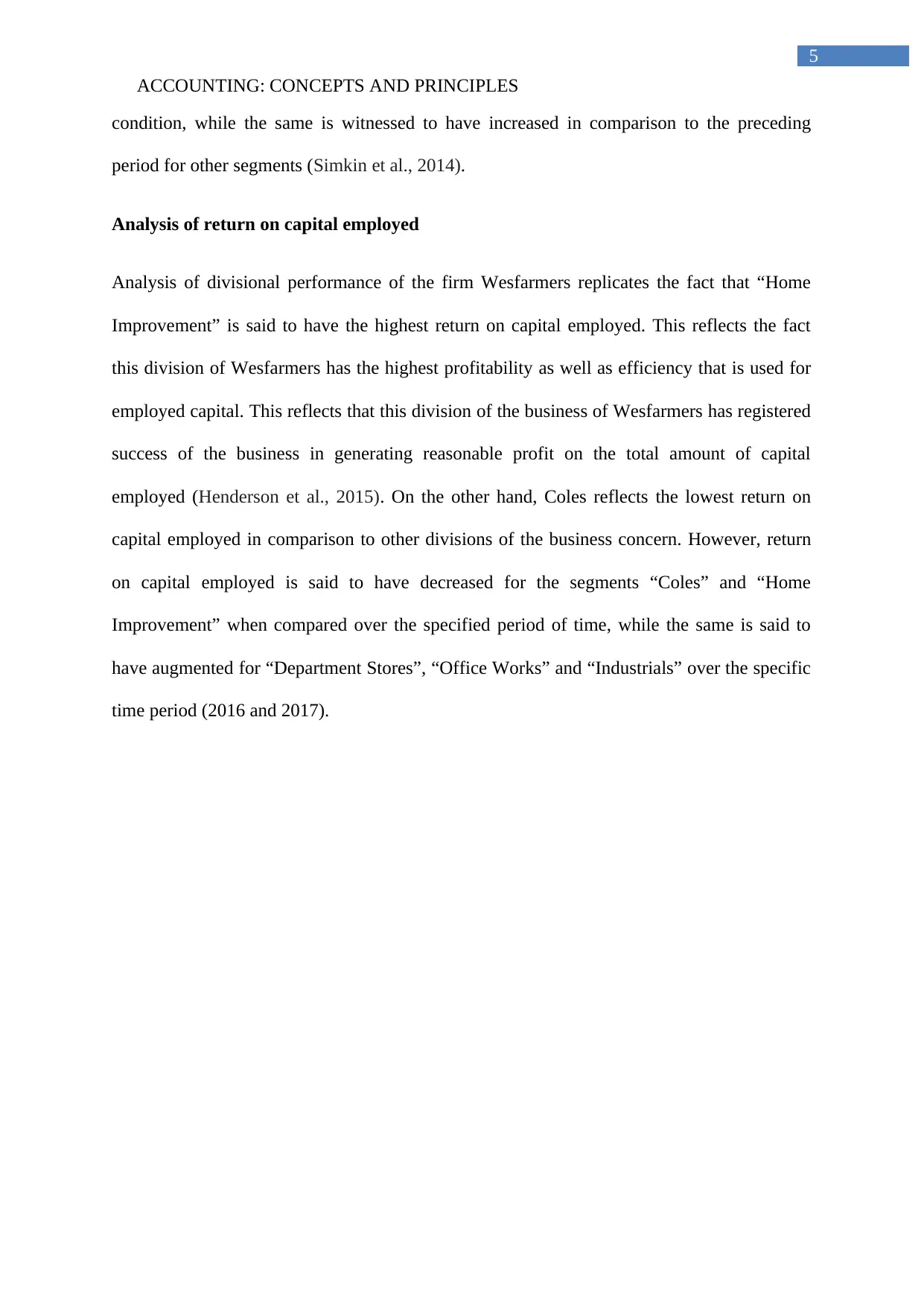
5
ACCOUNTING: CONCEPTS AND PRINCIPLES
condition, while the same is witnessed to have increased in comparison to the preceding
period for other segments (Simkin et al., 2014).
Analysis of return on capital employed
Analysis of divisional performance of the firm Wesfarmers replicates the fact that “Home
Improvement” is said to have the highest return on capital employed. This reflects the fact
this division of Wesfarmers has the highest profitability as well as efficiency that is used for
employed capital. This reflects that this division of the business of Wesfarmers has registered
success of the business in generating reasonable profit on the total amount of capital
employed (Henderson et al., 2015). On the other hand, Coles reflects the lowest return on
capital employed in comparison to other divisions of the business concern. However, return
on capital employed is said to have decreased for the segments “Coles” and “Home
Improvement” when compared over the specified period of time, while the same is said to
have augmented for “Department Stores”, “Office Works” and “Industrials” over the specific
time period (2016 and 2017).
ACCOUNTING: CONCEPTS AND PRINCIPLES
condition, while the same is witnessed to have increased in comparison to the preceding
period for other segments (Simkin et al., 2014).
Analysis of return on capital employed
Analysis of divisional performance of the firm Wesfarmers replicates the fact that “Home
Improvement” is said to have the highest return on capital employed. This reflects the fact
this division of Wesfarmers has the highest profitability as well as efficiency that is used for
employed capital. This reflects that this division of the business of Wesfarmers has registered
success of the business in generating reasonable profit on the total amount of capital
employed (Henderson et al., 2015). On the other hand, Coles reflects the lowest return on
capital employed in comparison to other divisions of the business concern. However, return
on capital employed is said to have decreased for the segments “Coles” and “Home
Improvement” when compared over the specified period of time, while the same is said to
have augmented for “Department Stores”, “Office Works” and “Industrials” over the specific
time period (2016 and 2017).
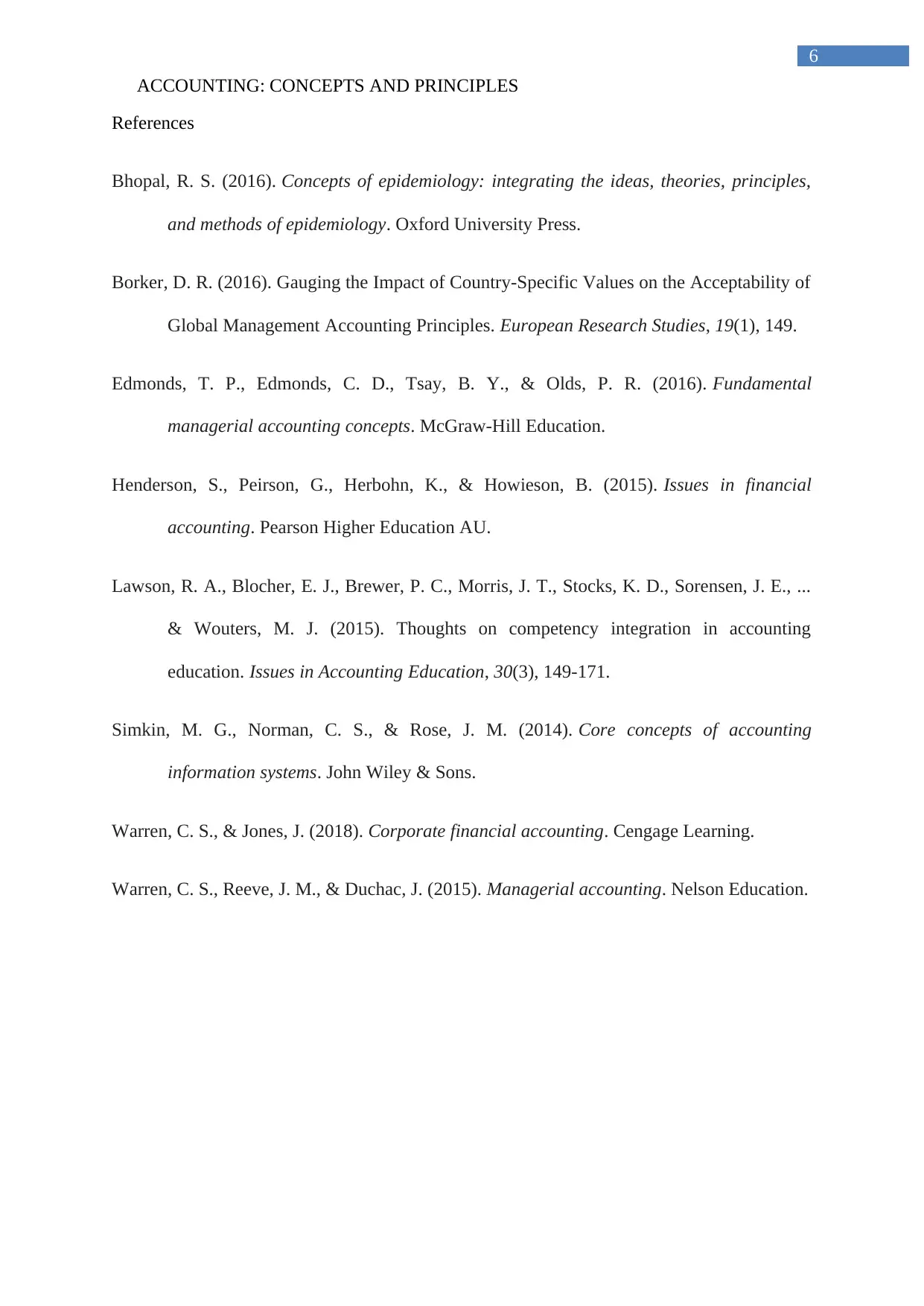
6
ACCOUNTING: CONCEPTS AND PRINCIPLES
References
Bhopal, R. S. (2016). Concepts of epidemiology: integrating the ideas, theories, principles,
and methods of epidemiology. Oxford University Press.
Borker, D. R. (2016). Gauging the Impact of Country-Specific Values on the Acceptability of
Global Management Accounting Principles. European Research Studies, 19(1), 149.
Edmonds, T. P., Edmonds, C. D., Tsay, B. Y., & Olds, P. R. (2016). Fundamental
managerial accounting concepts. McGraw-Hill Education.
Henderson, S., Peirson, G., Herbohn, K., & Howieson, B. (2015). Issues in financial
accounting. Pearson Higher Education AU.
Lawson, R. A., Blocher, E. J., Brewer, P. C., Morris, J. T., Stocks, K. D., Sorensen, J. E., ...
& Wouters, M. J. (2015). Thoughts on competency integration in accounting
education. Issues in Accounting Education, 30(3), 149-171.
Simkin, M. G., Norman, C. S., & Rose, J. M. (2014). Core concepts of accounting
information systems. John Wiley & Sons.
Warren, C. S., & Jones, J. (2018). Corporate financial accounting. Cengage Learning.
Warren, C. S., Reeve, J. M., & Duchac, J. (2015). Managerial accounting. Nelson Education.
ACCOUNTING: CONCEPTS AND PRINCIPLES
References
Bhopal, R. S. (2016). Concepts of epidemiology: integrating the ideas, theories, principles,
and methods of epidemiology. Oxford University Press.
Borker, D. R. (2016). Gauging the Impact of Country-Specific Values on the Acceptability of
Global Management Accounting Principles. European Research Studies, 19(1), 149.
Edmonds, T. P., Edmonds, C. D., Tsay, B. Y., & Olds, P. R. (2016). Fundamental
managerial accounting concepts. McGraw-Hill Education.
Henderson, S., Peirson, G., Herbohn, K., & Howieson, B. (2015). Issues in financial
accounting. Pearson Higher Education AU.
Lawson, R. A., Blocher, E. J., Brewer, P. C., Morris, J. T., Stocks, K. D., Sorensen, J. E., ...
& Wouters, M. J. (2015). Thoughts on competency integration in accounting
education. Issues in Accounting Education, 30(3), 149-171.
Simkin, M. G., Norman, C. S., & Rose, J. M. (2014). Core concepts of accounting
information systems. John Wiley & Sons.
Warren, C. S., & Jones, J. (2018). Corporate financial accounting. Cengage Learning.
Warren, C. S., Reeve, J. M., & Duchac, J. (2015). Managerial accounting. Nelson Education.
⊘ This is a preview!⊘
Do you want full access?
Subscribe today to unlock all pages.

Trusted by 1+ million students worldwide

7
ACCOUNTING: CONCEPTS AND PRINCIPLES
ACCOUNTING: CONCEPTS AND PRINCIPLES
1 out of 7
Related Documents
Your All-in-One AI-Powered Toolkit for Academic Success.
+13062052269
info@desklib.com
Available 24*7 on WhatsApp / Email
![[object Object]](/_next/static/media/star-bottom.7253800d.svg)
Unlock your academic potential
Copyright © 2020–2025 A2Z Services. All Rights Reserved. Developed and managed by ZUCOL.





